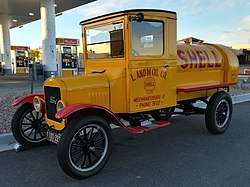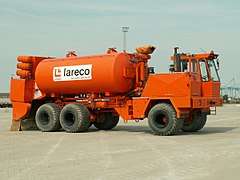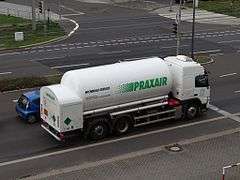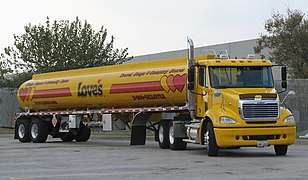Tank truck

A tank truck or tanker truck (United States usage) or tanker (United Kingdom usage), is a motor vehicle designed to carry liquefied loads, dry bulk cargo or gases on roads. The largest such vehicles are similar to railroad tank cars which are also designed to carry liquefied loads. Many variants exist due to the wide variety of liquids that can be transported. Tank trucks tend to be large; they may be insulated or non-insulated; pressurized or non-pressurized; and designed for single or multiple loads (often by means of internal divisions in their tank). Some are semi-trailer trucks. They are difficult to drive due to their high center of gravity.
Size and volume
Tank trucks are described by their size or volume capacity. Large trucks typically have capacities ranging from 5,500 to 11,600 US gallons (20,800 to 43,900 L; 4,580 to 9,660 imp gal). In Australia, road trains up to four trailers in length (known as Quad tankers) carry loads in excess of 120,000 L. Longer road trains transporting liquids are also in use.
A tank truck is distinguished by its shape, usually a cylindrical tank upon the vehicle lying horizontally. Some less visible distinctions amongst tank trucks have to do with their intended use: compliance with human food regulations, refrigeration capability, acid resistance, pressurization capability, and more. The tanks themselves will almost always contain multiple compartments or baffles to prevent load movement destabilizing the vehicle.
Common large tank trucks
Large tank trucks are used for example to transport gasoline to filling stations. They also transport a wide variety of liquid goods such as liquid sugar, molasses, milk, wine, juices, water, gasoline, diesel, and industrial chemicals.
Tank trucks are constructed of various materials depending on what products they are hauling. These materials include aluminium, carbon steel, stainless steel, and fiberglass reinforced plastic (FRP).
Some tank trucks are able to carry multiple products at once due to compartmentalization of the tank into 2, 3, 4, 5, 6 or in some rare cases more tank compartments. This allows for an increased number of delivery options. These trucks are commonly used to carry different grades of gasoline to service stations to carry all products needed in one trip.
Common small tank trucks
Smaller tank trucks, with a capacity of less than 3,000 US gallons (11,000 L; 2,500 imp gal) are typically used to deal with light liquid cargo within a local community. A common example is vacuum truck used to empty several septic tanks and then deliver the collected fecal sludge to a treatment site. These tank trucks typically have a maximum capacity of 3,000 US gallons (11,000 L; 2,500 imp gal). They are equipped with a pumping system to serve their particular need.
Another common use is to deliver fuel such as liquified petroleum gas (LPG) to households, commerces and industries. The smallest of these trucks usually carry about 1,000 US gallons (3,800 L; 830 imp gal) of LPG under pressure. Typically LPG tank trucks carry up to 3499 US gallons of product (usually liquid propane), on a 2 axle bobtail truck. 3500 US gallons (13,200 L; 2,900 imp gal) and greater requires a 3 axle truck (tank wagon). Some companies are using lightweight steel to carry more gallons on single-axle trucks. Notably, one U.S. manufacturer has built a 3700 US gallon tank truck, fitting it on a single axle.[1]
Tank trucks are also used to fuel aircraft at airports.
 Sewer vacuum truck
Sewer vacuum truck.jpg) Asphalt tank truck
Asphalt tank truck Cement tank truck
Cement tank truck Stainless steel milk truck
Stainless steel milk truck- Milk sold from a tank truck
 Street cleaner
Street cleaner Watering of plants from a tank truck
Watering of plants from a tank truck Compressed gas tank truck
Compressed gas tank truck- Firefighting water tender
 Tank trailer
Tank trailer- B double tanker

See also
References
- ↑ "Blueline® QX Bobtail - Westmor Industries". westmor-ind.com. Retrieved 2017-09-06.
External links
| Wikimedia Commons has media related to Tank trucks. |